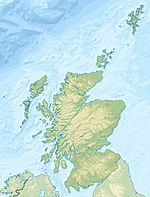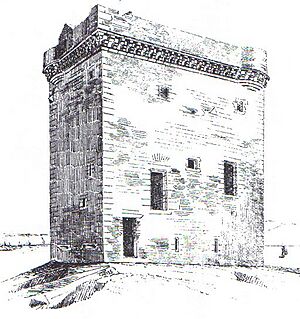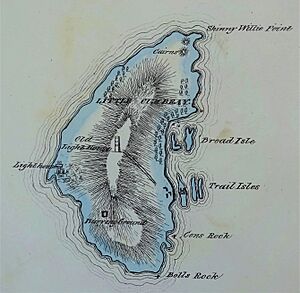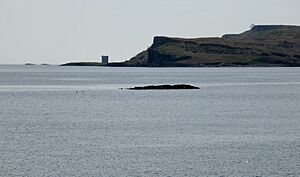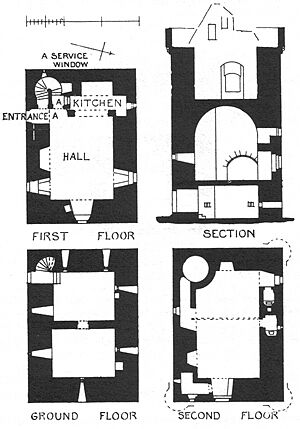Little Cumbrae Castle facts for kids
Quick facts for kids Little Cumbrae castle |
|
|---|---|
| Little Cumbrae, North Ayrshire, Scotland UK |
|
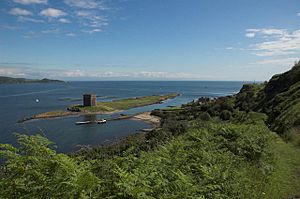
The castle as seen from Little Cumbrae
|
|
| Coordinates | 55°43′13″N 4°56′31″W / 55.7203°N 4.941811°W |
| Site information | |
| Owner | Private |
| Controlled by | Montgomery clan |
| Open to the public |
No |
| Condition | A substantial ruin |
| Site history | |
| Built | 16th century |
| In use | Until 17th century |
| Materials | Stone |
Little Cumbrae Castle is an old castle found on a tiny island called Castle Island. This island is also known as Allimturrail, which means 'the islet of the noble's tower'. It sits just off the east coast of Little Cumbrae in the Firth of Clyde in Scotland. Because of its history, the castle is now a protected site called a scheduled monument.
Contents
Discovering Little Cumbrae Castle's Past
Little Cumbrae has been known by different names over time, like Kumbrey around 1300. The castle you see today was built in the 1500s by Lord Eglinton. He might have built it to stop people from poaching, which is illegally hunting, deer and rabbits. These animals were very common on Little Cumbrae island back then.
For many years, the Hunter family of Hunterston were in charge of the island's forests. But in 1515, King James V gave Lord Eglinton control. The King thought Robert Hunter couldn't protect the island well enough. This arrangement lasted for 15 years. Later, the Crown sold the island to the Earl of Eglinton, who had his rights confirmed by King James V in 1555.
Early Royal Visitors to the Castle
Long before the current castle, there might have been an even older building here. Walter Stewart, who was married to Marjorie Bruce, the daughter of King Robert the Bruce, may have built a castle or hunting lodge. His son, King Robert II, loved to hunt deer on the island and spent time here in 1375 and 1384. King Robert III also visited Little Cumbrae Castle.
A Plan for a New Harbour
In 1599, Robert Boyd of Badinhaith lived in the castle. He had a big plan to build a harbour to help with trade. He even gathered materials for the work. However, some families, especially the Montgomerys, lived on Little Cumbrae and didn't want more visitors. The island was a quiet place, sometimes used by people trying to avoid trouble. The Montgomerys and about 30 men broke into the castle. They destroyed the harbour materials and furniture, forcing Robert Boyd out. They then took over the castle themselves.
There was also a small harbour at Brigurd Point on the Hunterston Sands. It is said that the local lords used this harbour for their trips to Little Cumbrae.
The Castle During Cromwell's Time
During the time of Oliver Cromwell, the Earl of Eglinton sent his wife to Little Cumbrae Castle for safety. He also sent 40 armed men to guard her. The castle's defenses were made stronger at this time. The Earl himself was captured after fighting against Cromwell at the Battle of Worcester in 1651. His wife was told to either give the castle to the authorities or have it knocked down after removing the weapons. Some stories say the Earl took refuge at the castle when Cromwell's soldiers threatened Ardrossan Castle.
A man named Principal Baillie of Glasgow also fled to the castle when Cromwell's army came near his city. He stayed with the Earl's wife.
Archibald Hamilton, who was a friend of Oliver Cromwell, was held prisoner in the castle's dungeon. He was later taken to Stirling. The castle was eventually attacked and destroyed by Cromwell's forces. After this, it was not rebuilt or lived in again.
Because Little Cumbrae was hard to reach, it was an important stronghold for the Earl of Eglinton. Ardrossan Castle, another of his castles, was easier to attack with cannons. In 1651, King Charles II allowed the Earl to keep 40 men at the Isle of Cumbrae.
In 1609, Robert Hunter was accused of going to Little Cumbrae and taking all the hawks.
The name Cumbrae might come from 'Cymri' or 'Kymry', meaning 'fellow countrymen'. It could also come from 'Kil Maura', meaning 'cell or church of a female saint'.
Animals of Little Cumbrae
The Normans brought rabbits to Scotland from Europe for their meat and fur. At first, rabbits were rare and valuable. They were often kept in special walled areas or on small islands like Little Cumbrae to protect them.
The 6th Earl of Eglinton was a very keen hunter. His letters show that he might have brought deer from Ireland to Little Cumbrae to improve the deer population.
Later, in the 1850s, the 15th Earl, George Montgomerie, brought rabbits to the island again. They bred so well that they became a problem! About 5,000 rabbits were born each year. The Earl would rent out Little Cumbrae to hunting parties, which brought in good money.
Castle Architecture and Design
This castle is a very important historical building. It looks a lot like other castles such as Fairlie Castle, Law Castle, and Skelmorlie Castle. The main hall, which had a vaulted ceiling, was on the first floor. The kitchen was also on this floor, which was quite modern for the time. You would enter the castle through the first floor, and an entrance to the ground floor was added later. The castle also had two vaulted cellars.
The tower had a special design with a pattern of stone supports and round turrets at three of its four corners. In 1568, a glassmaker named George Elphinstoun was hired to put glass windows into the castle.
Historians say the castle was once surrounded by a rampart (a defensive wall) and a ditch. The tower house was likely built in the early 1400s. The castle had three main floors. It had narrow openings for arrows and gunloops for defense. The original windows were small. The first-floor entrance would have been reached by a wooden ladder that could be removed for safety.
The castle is about 12.5 metres (41 feet) long and 9 metres (30 feet) wide. Its walls reach about 13.5 metres (44 feet) high to the wall-walk.
Local Legends
One local legend says that the De'il's (Devil's) son built Little Cumbrae Castle. The Old De'il was building a castle at Portencross at the same time. They were sharing tools by throwing them across the firth. But the only hammer was lost deep in the sea, and so both castles were left unfinished.


